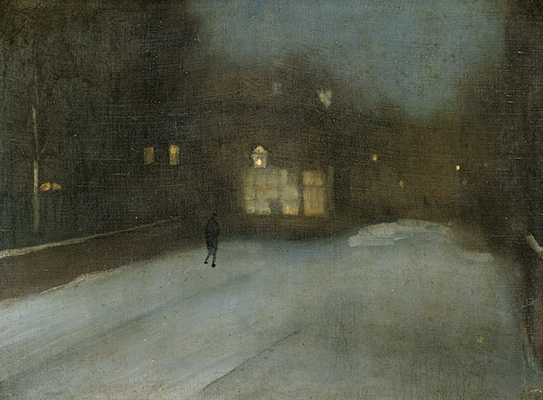On a boardwalk overlooking the rocky Maine coast, two women dance in the breezy moonlight. To their right, closer to the shore, a small group of people gaze at the moon. The shadowy figures are silhouetted against shimmering water and cresting waves, presenting a juxtaposition of humanity with the timeless forces of nature.
This evocative scene is depicted in Winslow Homer’s painting Summer Night (1890), on loan to the Harvard Art Museums from the Musée d’Orsay in Paris. Often described as one of the most important nocturnes in the history of American art, Summer Night is now featured prominently in Gallery 2700, which was reorganized for the occasion with a number of newly installed works from the museums’ collections.
Summer Night has become a key touchstone in the gallery, said Cassandra Albinson, the Margaret S. Winthrop Curator of European Art, who collaborated on the rethinking of the space with Ethan Lasser, head of the Division of European and American Art and the Theodore E. Stebbins Jr. Curator of American Art. Combining both European and American works of art from the late 19th and early 20th centuries and exploring transatlantic and transnational influences during the period, the gallery benefits in important ways from the addition of Homer’s painting.
Standout Scene
Summer Night was one of the first oil paintings Homer completed after settling in Maine in 1883, but the time he had recently spent in France remained salient. “You can see that Homer was looking at what was happening in French art and painting in ways that a French audience would have appreciated,” Lasser said, pointing out a passage in the center of the painting, where pointillist-like dots dapple the distant sea. Homer’s thick brushwork in other areas is more akin to the work of Monet and Courbet. And the influence of Degas, with his stage-like settings and detailed depictions of female dancers, is also apparent, Lasser said.
For 10 years, Homer was unable to find a buyer for Summer Night in the United States. In 1900, he sent it to Paris for the Exposition Universelle, where it promptly won a gold medal (and the admiration of Monet). The French state purchased the work for the Musée du Luxembourg.
Unlike many of Homer’s other nautical paintings, which include tough-looking men on rough, menacing seas, Summer Night shows a pleasant moment. Another unusual aspect? “We don’t see the moon—we just see people admiring the moonlight,” Lasser said. “It’s a radical choice to show a nocturne in this way.”
New Gallery Themes
“Nocturnes,” night effects, and dark scenes are a new thematic highlight of the refreshed gallery space. Curators were particularly excited to display another moonlit scene adjacent to Summer Night: James Abbott McNeil Whistler’s Nocturne in Grey and Gold: Chelsea Snow (1876).
Whistler had a particular interest in exploring urban environments at night. Painted just a few years before Summer Night, Whistler’s Nocturne in Grey and Gold depicts a person on a blustery street. With blurred colors and shapes, the scene has a dreamlike quality that some viewers might also perceive in Summer Night. However, the two paintings contrast markedly in tone and subject matter: Summer Night’s seemingly lighthearted, warm moment is far from the sense of coldness conveyed through Nocturne in Grey and Gold’s single, faceless traveler. The works make “a very provocative pair,” Lasser said.
Beyond the gallery, intriguing connections exist between Summer Night and other Homer works in the museums’ collections. Like Summer Night, Homer’s The Brush Harrow (1865), on display in Gallery 2100, features a tiny red dab of paint on the horizon. This bright speck is a device Homer used to convey space and distance. Lasser said he was excited to observe this parallel between the two paintings, despite their being created 25 years apart.
The museums’ collections also contain many of Homer’s watercolors, which portray nautical scenes, women, and other themes related to Summer Night. Visitors may view these works upon request in the Art Study Center.
Summer Night’s temporary stay in Cambridge is being matched by the loan of one of our own works, Jean Frédéric Bazille’s painting Summer Scene (1869), to the Musée d’Orsay, with additional stops at the Musée Fabre, in Montpellier, France, and the National Gallery of Art in D.C.




